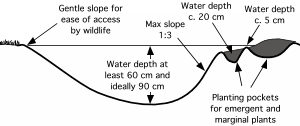Wildlife ponds 1: design
If there is one feature that all wildlife gardens should have it is a pond. A healthy pond swarms with life, and serves as a nursery for spectacular insects like dragonflies and for two of the gardener's most important helpers – frogs and toads. A large pond will support more varied aquatic life than a small one, but even a water-filled butt on the patio will be enough to tempt frogs and many insects to set up home.
Situation
A shady pond is better than none, but if possible site the pond open to the south so that plenty of sunlight enters the water, and with shelter from the prevailing wind. It is also best if it is not overshaded by trees, which cut out light and enrich it by dropping their leaves into it. Plants should run right up to it at some point, to provide cover for pond creatures entering and leaving.
A pond looks more natural in a hollow, but this brings the problem that it may flood in winter and the risk that heavy rain will wash debris and soil into it. Perhaps the ideal situation is on a slight slope or to one side of a dip, so that flood water can drain past and away. Drainage problems can sometimes be solved by running an overflow channel to a soakaway pit filled with rubble, but this will not be effective on a clay soil or if the whole area drains poorly. If you have no other option, it can be built on a steep slope by cutting into the slope and using the spoil to build up the lower end.
If you really have no space for a conventional pond, then a raised pond on patio or lawn is an alternative: see Raised ponds.
Materials
For small ponds, moulded or fibreglass pools are little trouble to install, especially if raised, but you are limited to the designs available.
Liners are the most flexible option. Butyl is best and will last for years if treated properly, but is also relatively expensive. (PVC is an alternative if money is short, but with a much shorter life expectancy and, unlike butyl, it deteriorates in UV light so should not be left exposed to sunlight.)
Concrete demands a lot of work and is not for the faint-hearted. It is also prone to cracking, and when this happens the best solution may well be to repair it with a liner anyway, so why not start off with one?
Shape and size
You need a minimum of 4 sq m to create a balanced environment, although smaller pools will work well if managed carefully.
If you are using a liner, allow for marginal shelves (at least 25 cm wide) to hold containers of emergent plants. Another option is to build in planting pockets – a good compromise between planting baskets used in formal ponds and the natural pond with a soil base which is very difficult to manage.
Avoid fussy shapes: go for sweeping curves with no sharp bends. A fat figure of eight or a kidney shape is good, because you can then include two zones of differing depths. A suggested profile for a pond with planting pockets is shown below.

Draw a rough cross-section of the pond to check how much depth you will get for your width. You need at least 60 cm depth for frogs to hibernate successfully, and ideally 90 cm or more. On normal soil, slopes should be 20° max. i.e. roughly 1 unit down for every 3 units across, to avoid the risk of slippage. You can get away with steeper slopes on a stiff clay soil.
